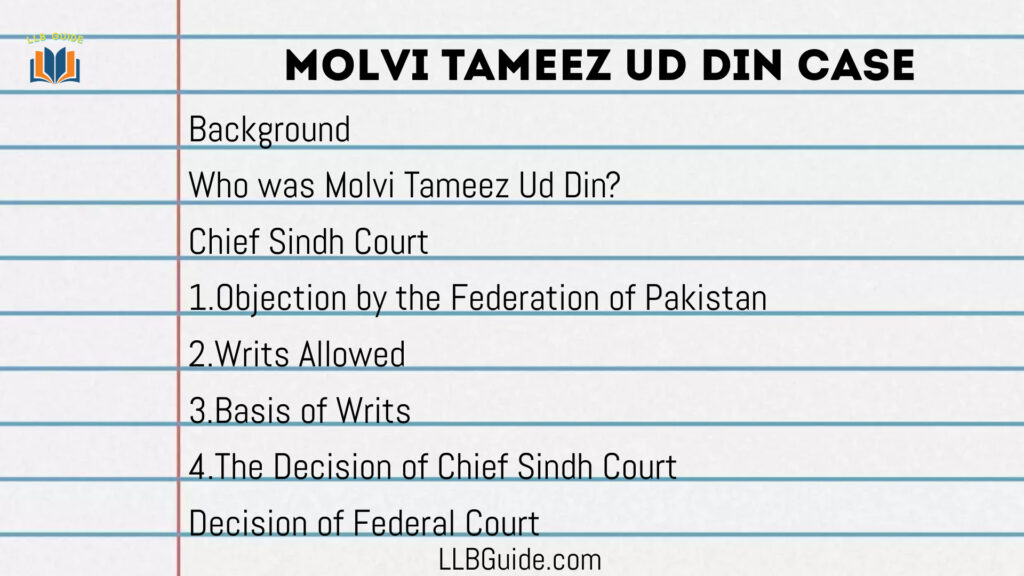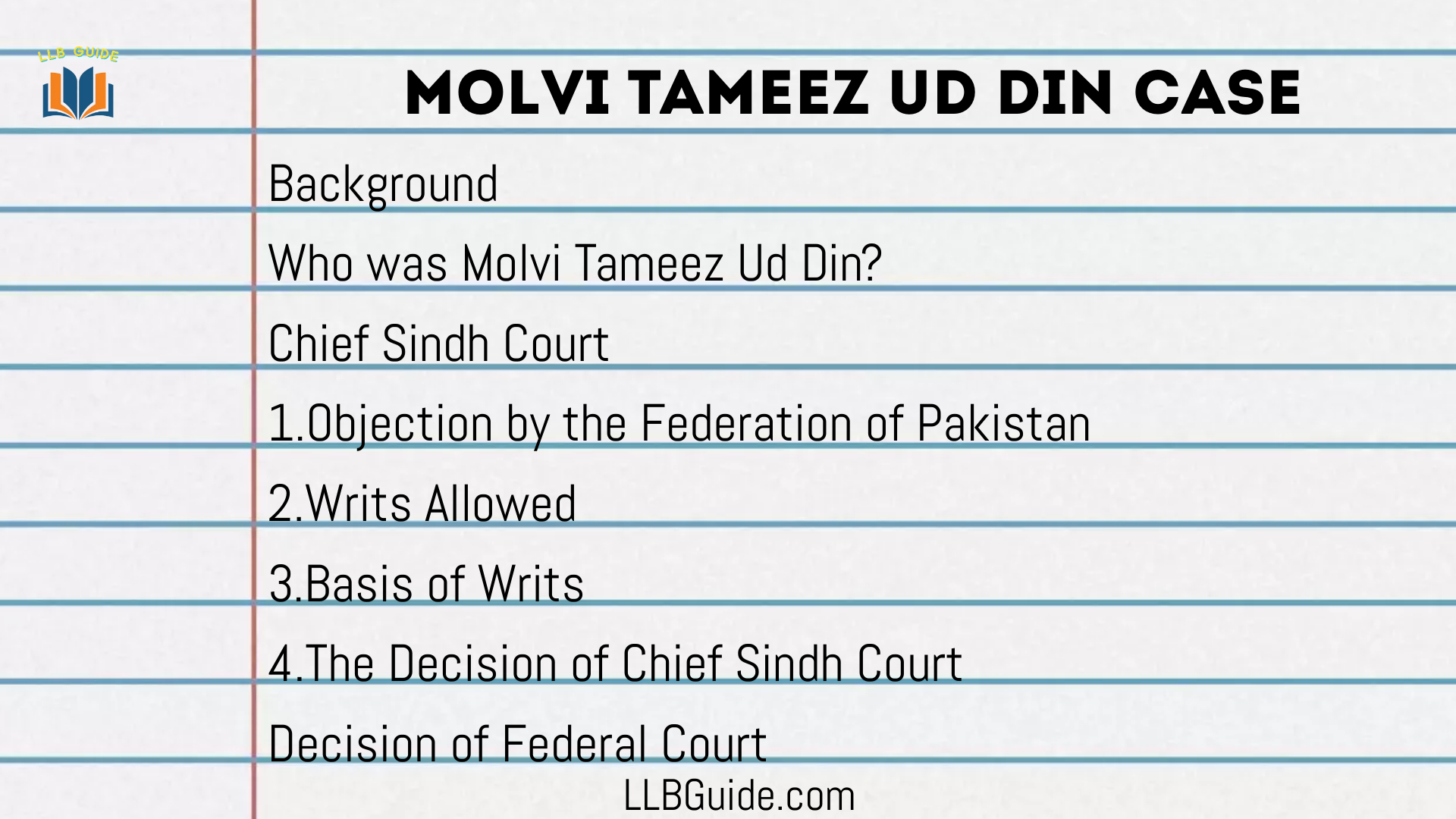In Molvi Tameez ud Din case, Molvi Tameez ud Din challenged the dissolution of the constituent assembly by the Governor General Mr Ghulam Muhammad, by filing two writ petitions namely writ of mandamus and writ of quo warranto in the Chief Sindh Court. The Chief Sindh Court decided in favour of Molvi Tameez ud Din. The Governor General appealed the decision in the Federal Court and the Chief Justice of Federal Court Justice Muhammad Munir decided in favour of the Governor General and suspended the decision of the Chief Sindh Court.

Molvi Tameez Ud Din Case PLD 1955
Molvi Tameez ud Din Case Vs. The Federation of Pakistan, PLD 1955 has been explained below.
Background
Pakistan came into existence on the 14th of August 1947, at that time Pakistan had no constitution but a constitution is a document which provides rules to run the affairs of a state, so Pakistan adopted the Government of India Act 1935 with some amendments as its interim constitution. A constituent assembly was also made which had these two purposes:
- To make a constitution for the country
- To work as a legislature
In 1953 the Governor General of Pakistan Mr. Ghulam Muhammad dismissed the Prime Minister of Pakistan Mr. Khawaja Nazim ud Din due to some disputes, in accordance with article 10 of the Government of India Act 1935 which was the interim constitution of Pakistan and appointed the current ambassador of Pakistan in the United States Mr. Muhammad Ali Bogra, as the new Prime Minister of Pakistan.
Mr. Muhammad Ali Bogra after being appointed as the new Prime Minister of Pakistan had the apprehension that the Governor General may dismiss him too, he made the two amendments in that interim constitution without the assent of Governor General Mr. Ghulam Muhammad.
These were the following:
- He repealed the article 10 (it provides power to dismiss the Prime Minister)
- He added the article 223A (it states the Court’s power to issue writs)
After some time there arose some disputes between the Governor General of Pakistan Mr. Ghulam Muhammad and the Prime Minister of Pakistan Mr. Muhammad Ali Bogra, which became the cause of the dissolution of the constituent assembly on 24th of October 1954, by the Governor General. The Governor General also appointed new ministers of his choice.
Who was Molvi Tameez Ud Din?
Molvi Tameez Ud Din was the President of the first constituent assembly of Pakistan which was dissolved by the Governor General.
Molvi Tameez Ud Din filed two writ petitions in Chief Sindh Court (currently Sindh High Court) under article 223A of the Government of India Act 1935 (the interim constitution).
Which were:
- Writ of Mandamus
- Writ of Quo Warranto
Chief Sindh Court
In Chief Sindh Court the proceedings of Molvi Tameez Ud Din Vs. Federation of Pakistan were the following:
Objection by the Federation of Pakistan
On the writs filed in the Chief Sindh Court by the president of the constituent assembly Molvi Tameez Ud Din, the Federation of Pakistan (the Governor General) raised objections as to article 223A which was added in the interim constitution through the amendment, that it had no assent of the Governor General so it did not become the law yet and the Chief Sindh Court has no jurisdiction to proceed with these writs.
Writs Allowed
The Chief Sindh Court overruled the objections raised by the Federation of Pakistan and allowed the writs filed by the Molvi Tameez Ud Din.
Basis of Writs
Molvi Tameez Ud Din filed:
- Writ of Mandamus to restore the constituent assembly
- And writ of Quo Warranto to check the capacity of the new cabinet
- He challenged the acts of the Governor-General as illegal and void.
The Decision of Chief Sindh Court
The full bench of the Chief Sindh Court decided in favour of Molvi Tameez Ud Din.
- The constituent assembly was restored
- It was held that the constituent assembly is the sovereign body and it can not be dissolved until it constitutes a constitution
- The full bench also validated these two amendments and it was held that there is no need for the assent of the Governor General for these amendments.
Appeal in Federal Court
The Federation of Pakistan appealed the decision of the Chief Sindh Court in the country’s apex Federal Court (currently the Supreme Court).
Decision of Federal Court
Justice Muhammad Munir was the Chief Justice of the Federal Court, and the Federal Court decided in the favour of Governor-General.
- Repeal of article 10 and addition of article 223A was declared as null and void
- The Chief Sindh Court has no jurisdiction to proceed with the petitions
- The decision of the Chief Sindh Court suspended
- Appeals were allowed and the writs filed by Molvi Tameez Ud Din were dismissed
- It was held that according to the Government of India Act 1935, the assent of the Governor General was necessary for legislation.
Conclusion
Molvi Tameez Ud Din Case was the first constitution case in the history of the constitutional development of Pakistan, it is a reported case. The judgement given by the Chief Justice of the Federal Court, Justice Muhammad Munir was criticized.
FAQs
What was the Judgement of Justice Munir?
Chief Justice of Federal Court Justice Muhammad Munir decided in favour of the Governor General and suspended the decision of the Chief Sindh Court.
Which court is Molvi Tamizuddin?
Molvi Tameez ud Din was the President of the Constituent Assembly.
Who dissolved the first Constituent Assembly of Pakistan in 1954?
The Governor General of Pakistan Mr. Ghulam Muhammad dissolved the first Constituent Assembly of Pakistan in 1954.
Who dismissed the cabinet of Khwaja Nizamuddin?
The Governor General of Pakistan Mr. Ghulam Muhammad.
#Molvi #Tameez #Din #Case







